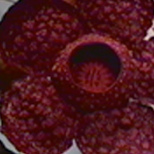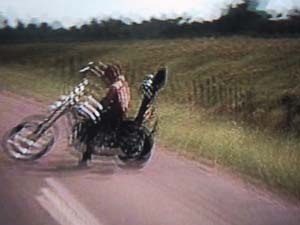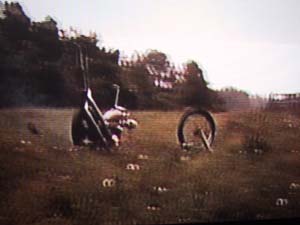|
|

Big leaf maple

lobaria
It’s early April on this little island and the rainforest is waking up. Some of the largest maples on earth are beginning their annual flowering cycle. Rising up to over a hundred feet, their trunks and branches are festooned with epiphytes and a thick pelt of mosses hiding a thin microcosmos of curious arboreal soil inhabited by unique tiny arthropods existing nowhere else. Like terrestial coral reefs, these enormous trees form fractal frameworks that rake the sky. A furry pelt of botanical symbiots (mosses, lichens and ferns) wrings moisture and minerals from the soft marine air, feeding them through the bark into the throbbing sapstream of the living tree. Some, like the strange floppy lobaria lichen, actually extract gaseous nitrogen from the air via their *own* internal colonies of cyanobacteria, fixing it into their tissues, to fertilize the forest soil when blown down by the howling south-east storms of autumn.
Sadly this exquisite symphony of nutrient cycles and ecological interchange; this apogee of rarified botanical evolution, lies prone on the chopping block of capitalist utilitarianism. This grove, in particular the red cedars, Douglas firs, hemlocks and Sitka spruces that grow here, are worth more dead than alive and can be exported overseas as raw logs if some way can’t be found to buy the land they stand on. Living amongst these towering trees tears me between the euphoria of being immersed in their seething life force and the deep sadness of constantly contemplating their demise. How can these ancient dark and melancholic trees stand up to the banal brightness of our commerce? They have stood like sentinels through the quiet of a hundred and fifty winters yet faithfully unfurl their massive handlike leaves to the promise of each spring. Now, sadly their fate is in *our* hands; furtive, scuttling creatures, (to quote Kurt Vonnegut) our judgement constantly impaired by “big brains and short lives.” We don’t deserve such power. Yet it is our fate to exercise it.
Down in Vancouver, after working on my Means of Production project, my pals at EYA, knowing my penchant for studying ruderal ecologies, snuck me through a hole in a chain link fence into a secret urban Arcadia. A former train yard, the vast expanse of gravel track bed has been colonized by dwarfed birches (uncommon in urban Vancouver) and sweetly fragrant cottonwoods redolent with the intoxicating *balm of gilead* exuded as their buds were caressed by the warm spring sun. We trudged further. . feeling strangely enveloped by the place’s bizarrely Nordic, post-apocalyptic spiritus locii. As in a dream, I suddenly thought of the *zone*, the parallel universe depicted in Tarkovsky’s The Stalker. Averting my gaze from the horizon and its industrial buildings, I imagined being inside some German Romantic painting by (say) Caspar David Friederich or that I was traversing some stony subalpine pasture high in the Hindu Kush or Syria, flush with the new growth of spring. This wasteland was becoming verdant once again, having (for now) escaped the forces of bureaucratic tidiness by hiding in the city’s interstices.
At the edge of this strange paradise lay an abandoned jumble of enormous concrete pipes, some upended, some lying down; their cement skins spalling off, eroded by relentless winters of rain, allowing the rusty iron skeletons to spring out insanely from their long years of confinement. Stuffed with sodden bedding and shored up from the night winds with bits of brush, these were the rough homes of a demi-monde of *tube dwellers* Alas, abandoned syringes lay everywhere.. I wonder if their wishes came true ?

ruderal cottonwoods

ruderal hiking

ruderal wetland birch forest

tube landscape

tube dwellings

inside tube dwelling

double pink cherries

yoshino cherries
As if controlled by the strange lever-wielding *man in the planet* character in Eraserhead, the season has once again lurched into gear and I find myself inundated by the seething fecundity of spring. The trumpeter swans have already migrated over this little island, in wheezing, flapping north-bound skeins, having spent the winter grazing on the sweet green swards of the Comox Valley. Now the year’s first vultures are lazily spiraling up the thermals, gazing casually down at me as I cross the meadow in case maybe, just maybe, I suddenly drop dead. Crocuses and pussy willows have come and gone, giving way to cadmium-yellow daffodils and the libidinous trilling of frogs.
The suburban landscapes of Victoria and Vancouver are lysergic with a display of botanical rococco. Band-Aid pink blossom clouds of Japanese cherries billow over glistening streets, the drifts of their fragrant benedictions piling up on parked cars. Forsythias explode from behind chain-link fences, like blinding showers of sparks from the grinding of metal. Purple hyacinths erupt unabashedly though the dog doo-dooed detritus of a long grey winter.
Of course, we might have to kiss all of this natural splendor good-bye, as the signs of what is being called “The 6th Great Extinction” are starting to really pile up. They’re little things, each of them, but when taken in total, they point to an unprecedented human-initiated crash in biodiversity that is, right this minute, leading to a massive impoverishment of the planet’s natural infrastructure. The above link functions as kind of an “extinct-o-meter” and really gives a sense of the *cumulative* nature of this crisis. It really is the death by a thousand needles.
A typical news story this week reports on an exhaustive study of butterfly biodiversity which found that an astonishing 71% of British butterfly species declined over the past 20 years. So what? you might ask, but many butterflies have symbiotic relationships with the plants they pollinate, and they in turn will go extinct without the butterflies to pollinated them. Of course butterflies and their nocturnal moth cousins are vulnerable to the insecticides used everywhere in agriculture, but lately, they are being killed en-masse by crops such as corn, which have been genetically engineered to produce the Bt toxin. The insecticidal *pollen* from this corn can be carried great distances in the wind and has been implicated in the sharp decline of such familiar species as the North American monarch butterfly. As children growing up in suburban Toronto, we used to collect the spectacular, Cercropia, Polyphemus and Luna moths and would bring them to school alive in cookie tins. Now these exquisite creatures seem to have largely vanished and today’s suburban children will only ever see them in museum displays or on video.
As well as killing butterflies, genetically engineered pollen risks destroying the very genetic commons that has allowed corn to survive climate change, pests and diseases for millennia.. Corn is a product of 9,000 years of symbiosis and coevolution between the human cultures of the Americas and a now vanished wild plant. Within the gene pool of the diversity of traditional Mexican corn varieties, reside the genetic algorithms containing corn’s history and its armamentarium of strategies to adapt to changing conditions. These ‘libraries’ are now being contaminated by pollen from (unlabelled) genetically engineered corn that was imported into Mexico via the United States. It was originally meant for animal feed but wound up getting planted by poor farmers, who couldn’t afford to buy seed corn. This germ-plasm contamination is one of the worst case scenarios that anti-GMO activists have been predicting during the last few years and now that it has come to pass, it really underscores the demented-ness of not having labelling requirements for GMO materials that are distributed in the United States and Canada.
Somewhat perversely, one of the outcomes of widespread GMO pollution is the emergence of an entire industry providing testing services for markets that *don’t wan’t to be contaminated* with what agrobusiness is trying to ram down the world’s throat. For example, IdentiGen tests foods for GMO content and will issue a ‘Non-GMO’ certificate for products that prove uncontaminated by them. A ‘GMO free’ status has now become an attractive value proposition for many food manufacturers. It is easy to understand why agribusiness is deliberately contaminating our airsheds with as much GMO pollen as possible, in order to ultimately prevent their organic competitors from successfully achieving market differentiation, by keeping their crops ‘GMO free.’ Organic farmers in the US are already finding GMO pollution in their fields and are increasingly fearful that their $10 billion-a-year industry will be rejected by European consumers, used to tighter regulation.
Although GMOs are doubtlessly playing their part in the current mass extinction episode, it is perhaps worth remembering that the Earth has suffered through them before, albeit not (to my knowledge) as a result of the deliberate stupidity of a single *virus* species like Homo sapiens. My old friend Ian has been studying fossils of extinct forests and he sent me his treatise on “Morphotyping the McAbee Flora” (unfortunately not archived online) in which he starts to catalog the exquisite paleobotany of a Kamloops BC area sedimentary deposit, dating from the Eocene era, 55 million years ago. Before the mass extinction event that occured at the end of *that* unusually warm period, the now dry and cold interior of British Columbia was covered in a lush and highly diverse mixture of temperate and subtropical trees such as Ginkgo, Metasequoia, Sassafras and Sycamore as well as many other species that have passed into extinction. The leaves and seeds of these trees left exquisite impressions in the area’s fine grained, silty rock and Ian is working on a digital photo archive of these fossils. (This would seem to be a great application for Plone’s CMFPhoto product, perhaps accompanied by lively zwikis in which the identity of the mysterious “incertae” could be discussed)
Ian and I went to art school together in Toronto, a city which, in prehistory like the planet Mars, had been inundated by a warm ocean. Growing up in its suburbs, I watched the landscape which had been buccolic and rural during my childhood, get transmogrified into a Ballardesque wasteland of shopping malls and industrial parks, by the time I was an adolescent. Throughout the devastated farmland, pock-marked by countless excavations for the foundations of new parking garages and tract homes, lay huge gray spoil piles of shale and mudstone, through which I used to pick to find almost perfect lithographic impressions of sea creatures such as scallops, corals and sea-lilies. These fossils were all that remained the ancient Ordovician ocean that had covered the area 450 million years ago. I would often collect curiously sectored, cornucopia-shaped objects, beautifully petrified, for which there seemed to be no contemporary equivalent. These proved to be the remains of cephalopods and nautiloids – long extinct squid-like creatures whose tentacled heads emerged from a kind of chambered tusk which they propelled backward through the limpid coralline sea.

Cephalod fossils I collected in suburban Toronto
The presence of these invertebrate fossils seemingly scattered all over its landscape, produced some remarkable effects on Southern Ontario’s culture. Marshal McLuhan, for example, appeared in a widely circulated photograph (taken by the famous Canadian photographer Karsh) posed in front of the seminal, interactive *invertebrate paleontology* exhibit at the Royal Ontario Museum. I remember being beguiled by this exhibit (designed by McLuhan’s associate Harley Parker) when I first saw it as a young boy, and I dutifully picked up the telephone receivers and listened to reassuring narratives on the evolution and subsequent extinction of the trilobites. Somehow this put the ecological carnage I saw wrought by the metastasizing development industry, into some kind of long-term perspective.

Marshall McLuhan *extends* Invertebrate Paleontology
Inspired by such fossils, the remarkable poet Christopher Dewdney wrote the wonderful “A Palaeozoic Geology of London, Ontario” in 1973, which ironically has become a rare fossil in itself, because (according to one source):
workmen involved in a move (at the publisher, Coachhouse) inadvertently pitched most of the unbound copies of the limited edition into the garbage.
These were the days before digital backup and on-demand publishing.
Fossilized reefs and inundation figure prominently in the work of J. G. Ballard, for example in The Drowned World (1962) and The Cloud -Sculptors of Coral D (1973). Last week, the venerable self-described *terrorist-novelist* gave an amazing interview on BBC World’s Profiles series. The interview was shot in various bleak suburban locations in Shepperton near Heathrow Airport. In describing these environments Ballard said:
The equivalent of the desert today are these large shopping malls and industrial parks, which allow the imagination begin to fester . . . where the individual is sort of finessed out of existence. . . .
I was pleased to see Ballard’s review of Mike Davis’ brilliant book – Dead Cities in the Guardian last spring. Davis’s books are very blog-like; quite non-sequiturious and essay-like. Dead Cities has a particularly interesting chapter on ruderal ecologies entitled “Dead Cities: A Natural History” in which Davis describes the stages of succession that nature follows to reinvade the built environment, especially after humans have been temporarily displaced by (for example) bombing or as in the case of Chernobyl – radioactive fallout. Even in our bleakest rubble fields and toxic waste dumps, hope does indeed spring eternal. . .

Dachau (picture taken 1983)

Guantanamo (via BBC)
Sir Ian McKellen recently gave an absolutely endearing interview on the BBC’s HardTalk, in which, in addition to discussing his role as the Lord of the Ring’s Gandalf, he spoke extensively about his activism for gay rights. Says McKellen:
“The world is a much more interesting place than fundamentalists allow it to be (and) The President of the United States is inexperienced in this way. It hurts me to imagine that the constitution of this great country thinks it’s unsuitable for me to have a relationship that is on par with that of Mr. and Mrs. Bush.”
Now there’s a wizard I can believe in!
One the most intriguing parts of the LOR trilogy was Gandalf’s transformation from Gandalf the Grey into Gandalf the White, after having plummeted to a flaming abyss in a mortal struggle with the Balrog, in the Mines of Moria. According to Wikipedia’s entry on Gandalf: the change of color is significant, for he has come to replace the corrupted Saruman as the chief of the Wizards. In a sense he has become Saruman, or rather what Saruman should have been.
In his transformation to whiteness and thereby to a higher level of wizardry , Gandalf exhibits a kind of protean quality; a fluidity of personality which quite often exists even in mere mortals. Proteanism is about self-reinvention as an adaptation to changing conditions. The psychohistorian Robert Jay Lifton explores this phenomenon in his 1993 book, The Protean Self- Human Resilience in an Age of Fragmentation The book is a relatively uplifting work which presents a number of case studies of people who have completely reinvented themselves as a response to changing parameters in their lives. But there is a dark side to this and Lifton is perhaps one of the world’s foremost authorities on the nature of intrinsic evil. I first ran into Lifton’s work several years ago when I got a job skimming through his archive of research notes and correspondences at the New York Public Library. I was developing background for a Japanese television documentary. Because of my somewhat rudimentary command of German, I was asked to go through the transcripts of the interviews that Lifton did for his seminal book Nazi Doctors. The book explores the peculiar phenomenon of “doubling” in which seemingly unremarkable, middle-class German professionals were able to perform appalling medical experiments on living concentration camp inmates, as a matter of routine and then at the end of the day, go home to their wives and children – as if nothing unusual had ever happened. Lifton theorizes that we carry within us the ability to *compartmentalize* and to literally develop another personality that becomes comfortable with performing activities previously abhorrent to our quotidian sense of morality. The frightening thing is that this means that genocide is carried out, not by a few lone psychopaths, but by many, compliant outwardly normal individuals, eager to gain approval from power structures that have become demented. It really is about unquestioningly buying into the *new normal.*
The Globe and Mail recently published an insightful review on Lifton’s new book Superpower Syndrome: America’s Apocalyptic Confrontation with the World – a psychohistorical analysis of the United States’ foreign policy since 9/11 in which Lifton examines the Bush administration’s reactionary and apocalypticism and fundamentalist sense of righteousness and mission.
The warning from Lifton is that hegemony can become normalized pretty quickly, especially when a culture perceives itself to be under some kind of threat. We now live in an age where (at least in the US) the detention of hundreds of “illegal enemy combatants” without charges, lawyers or any public scrutiny has become routine and that even *publishing* works by writers from certain countries such as Iran will incur “grave legal consequences “ if, (according to the New York Times) illustrations are added, grammer and syntax corrected or paragraphs are reordered. The Times quotes Nahid Mozaffari, a scholar and editor specializing in literature from Iran, who calls the implications staggering. “A story, a poem, an article on history, archaeology, linguistics, engineering, physics, mathematics, or any other area of knowledge cannot be translated, and even if submitted in English, cannot be edited in the U.S.,” she said. When hearing about the rapidly deteriorating human rights climate under the Bush administration, I am haunted by recollections of my own parents’ accounts of experiencing the rise of the Nazis, as children growing up in Germany. It began with patriotic fervour and the trains running on time and then suddenly- the neighbours began to disappear. . . The road to totalitarianism is paved in increments.
And while I’m on the topic of information control, I was flipping through a recent Vanity Fair (which doesn’t appear to be archived on-line) and between pictures of Gwyneth Paltrow and a Versace ad, I noticed a beguiling (if somewhat incongruously placed) photograph by Subhankar Banarjee. It featured a loon nesting on the shore of a pristine tundra lake, in the middle of the vast landscape of Alaska’s Arctic National Wildlife Refuge. It turns out that officials in the Smithsonian Institution, under pressure from Congress, had a show of Banargee’s photos moved from a prominant location to a marginal basement gallery, after the controversial Boxer-Chafee amendment was passed. They also ordered the removal of the descriptive passages from the photographs and demanded that Banerjee’s publisher take out references to the Smithsonian from a book containing the pictures. It seems that the photographs depicting the fragile beauty of the arctic Alaskan ecosystems were deemed too political to serve up uncensored, to an American public being primed to accept the incursion of oil rigs into one of the last pristine wildernesses on the continent.
Laura made a rather elegiac post a little while ago about ‘lighting the beacons‘, inspired by the magnificent scene in The Return of the King of a chain of beacons being lit, one by one, on snow-capped mountain peaks, in order to summon the Rohirrim to come to the aid of Gondor. We watched this film over New Years, together with Ruth and we all agreed that lighting the beacons was a powerful trope for how we saw ourselves as activists, writers and bloggers. Despite the gathering clouds of hegemony, we can take heart from the efforts of such disparate individuals as Sir Ian McKellen, Robert Jay Lifton and Subhankar Banarjee, to shine light on the darkness that threatens to engulf us.
Of course the way net culture facilitates the dissemination of ideas and the organization of dissent is one of the very brightest beacons of hope against increasingly repressive. political and corporate institutions. There has been a lot of hype lately about social networking software such as Orkut and Friendster which (although the marketing seems to focus too much on the facilitation of *dating*) have the potential to be used as powerful tools for community building. I was particularly pleased to see a link to a discussion on wikis as social networking software, via the many2many weblog. This posting (on Darwin) was the best description I’ve seen of the anarchic, *swarminess* of wikis, which always feel like they might at any time implode but are ultimately utterly stable. My plone site is set up for wikis (actually zwikis) which anyone who becomes a member can add and use. ( I am in the middle of a messy migration to Plone 2.0 though, so please be patient with any glitches) The structured text (STX) syntax that zwiki utilizes is a powerful yet simple shorthand for linking to other posts and is painless to learn. *And* you can edit other people’s stuff !
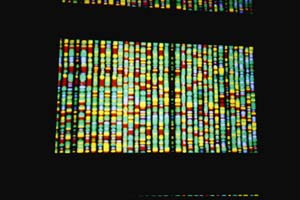
Gene map- American Museum of Natural History
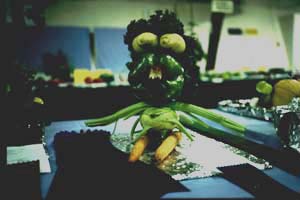
Veggie Art- Courtenay BC, Fall Fair
After reading my last post, Derek sent this useful link to a PDF of Raoul Robinson’s brilliant work on self-organizing agricultural systems. which, in addition to describing the theory of “horizontal resistance” in plant breeding, serves as a great little primer on the principles of emergence and complexity theory, as applied to ecological systems. Robinson’s idea of allowing the natural chaos extant in the genetics of plants to generate dynamic resistance to pathogens, is revolutionary and the exact opposite of contemporary agribusiness’s tunnel-vision focus on (patentable) single genes. It is so *zen* to realize that complex living systems can respond to ever-changing stresses, if only they are allowed to maximize diversity and left to *self-organize*. And the engine driving this is *chaos* – the seething emergence of adaptation enabled by embodied genetic diversity. The more diverse the genetics, the greater the variety of resistance strategies available. There are definitely some larger lessons to be learned here. And best of all, this brilliant publication is *free*
My pal Sascha Scatter (also a big Raoul Robinson fan) and inveterate peripatetic guerilla gardener, reports on the Icarus Project. I love the post; “Head like a funnel and the world pouring in”
In a recent chat, Laura told me how cool the computer language, python is, and pointed me to another *free* and very useful download entitled “How to think like a Computer Scientist -Learning with Python. This is an absolutely amazing tutorial that helps the novice make the conceptual leaps necessary to *get* programming and (from what I can tell), python, seems to be a very sensible, very understandable language at least syntactically- yet is extremely powerful. One of my favourite tools, plone, is written in python, so I can’t wait to start learning it.
Iceland is apparently home to a disproportionate number of clairvoyants who freely communicate with *invisible beings*. The strangely beautiful 2002 film- “Investigation into the Invisible World” details this peculiar phenomenon as well as the Tolkeinesque cast of parallel beings such as elves, trolls, light-fairies and mountain spirits reputed to inhabit Iceland’s windswept volcanic landscape. Belief in “hidden folk” seems to permeate all walks of life in Iceland, and there are interviews in the film with a highways department bureaucrat, the former Prime Minister and a police officer, all of whom matter-of-factly concur with this notion. Oh, BTW, the elves *live inside rocks*
I was so pleased to find this story about a new species of jellyfish just discovered off the California coast, which endearingly has only *four* little arms. Up here around Cortes Island, the ocean just teems with jellyfish at certain times of the year, which is why I used one for the logo of my plone site. There is nothing like skimming across a mirror black sea in a kayak and looking over the side and seeing millions of purple and chartreuse jellyfish pullulating in the inky depths. You feel kind of weightless and, well, *free*, like floating in a vast holographic rendering of an early Kraftwerk record label. But, I have to confess, the little specimen depicted in my logo was actually photographed in an aquarium deep in the vast Takashimaya department store, far from the limpid lagoons of Cortes Island, in the metastasized techno-landscape of Shinjuku, Tokyo. It seems that jellyfish were the *it* pet that year and this little creature had rather photogenically positioned itself opposite someone leaning against the tank, wearing a t-shirt covered in Greek letters. Well, I just had to photograph it. . .
 |
The BBC World series Capitalism, presented an interesting discussion of what *freedom* means in its last episode on Globalization. In reference to Frances Fukuyama’s deeply flawed “End of History” thesis, one of the panelists (the former chief economist for British Airways) reduced contemporary globalized capitalism down to “the economic dimension of freedom” and democracy to “the political dimension of freedom.” She was vigorously rebutted (fortunately), and then I nearly fell out of my chair when the panelists started to then discuss the relevance of Marx’s theory of alienation in the contemporary globalized economy. The fact that they were having the debate *at all* was refreshing, given the fact that Marx has been more or less completely expunged from North American cultural memory, or relegated to the status of historical boogy man. This discussion was my first exposure to the term term “politics of scale” to describe the immense power and political influence wielded by multi-national corporations over government policy.
George W. Bush’s pious, platitudinous torrent of rhetoric on “the enemies of freedom” made me think back to the seminal 1969 film Easy Rider. George, the drunken ACLU lawyer (played by Jack Nicholson) has this memorable exchange around the campfire with Billy, (Dennis Hopper), before being beaten to death in his sleep, by vindicitive, xenophobic southern ‘bubbas.’
Billy: Hey man. All we represent to them, man, is somebody needs a haircut.
George: Oh no. What you represent to them is freedom.
Billy: What the hell’s wrong with freedom, man? That’s what it’s all about.
George: Oh yeah, that’s right, that’s what it’s all about, all right. But talkin’ about it and bein’ it – that’s two different things. I mean, it’s real hard to be free when you are bought and sold in the marketplace. ‘Course, don’t ever tell anybody that they’re not free ’cause then they’re gonna get real busy killin’ and maimin’ to prove to you that they are. Oh yeah, they’re gonna talk to you, and talk to you, and talk to you about individual freedom, but they see a free individual, it’s gonna scare ’em.
Billy: Mmmm, well, that don’t make ’em runnin’ scared.
George: No, it makes ’em dangerous.
Of course Easy Rider is full of Fetish:Footage and I’ll close with a couple of screen snaps that I grabbed with my trusty digital Elph . . .
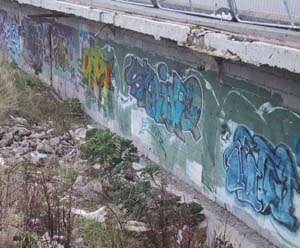
wild kale
Kale seems to be one of the most vigorous food plants in the world. It’s tremendously good for you and it kind of just grows itself. Once it’s planted it keeps seeding itself out. Here on the west coast, it provides people with fresh green vegetables all winter long. Kale tastes better in the winter because the leaves concentrate sugars which also serve as a natural antifreeze. Former students of mine have been scattering kale seed from Cortes Island, all over the Lower East Side of New York which is now growing into kale that people can eat. I found the wild specimen in the picture, growing beside a parking lot in Victoria BC. Kale is a wonderful vegetable symbiot. The kale varieties in my backyard are constantly cross-breeding and seem to self organize and *evolve* to deal with drought, pests and exposure to cold. Raoul Robinson in his radical book Return to Resistance, promotes this kind of anarchic botanical promiscuity as a way of inducing *horizontal resistance* in agricultural crops. Robinson’s breeding technique of *recurrent mass selection* creates a high degree of genetic variability from a large gene pool within the crop to allow it to adapt to continually changing conditions of pests and disease. This is the exact opposite of traditional plant breeding, which aims to create uniform genetics, and characteristics. There is a vigorous movement of plant hackers who are busy working against the *great homogenization* of our food supply being instigated by multi-national agro-business. One of the foremost of these is “open source” seedsman J.L Hudson (aka David Theodoropoulos). His catalog features amazing seeds but also his fascinating and insightful writings on biodiversity, for example his manifesto:
We recognize that the biological diversity of the Earth and the diversity of all cultivated species are the common heritage of all humanity and we REJECT the theft of the biological commons by individuals, corporations and governments through plant patenting, gene patenting, Plant Breeder’s Rights (PBR), Plant Variety Protection (PVP), or any other form of intellectual property applied to living things. We reject life patenting in any form . . .
The parallel to the Open Source software movement is striking here and it would seem reasonable that botanical otaku and computer hackers form alliances against the privatization of the genetic and intellectual commons. (More on this to come . . .) Hudson’s explicitly “uncopyrighted, all rights released” catalog reflects his attitude towards open source botanical germplasm. Maybe he should put a Creative Commons license on it. It’s worth sending away for his catalog just for the narrative! Here is a sample entry:
‘POMEGRANATE’ Spectacular brilliant deep orange-red flowers 1-2″ across, sometimes reaching 4″, from succulent scarlet buds. satiny crinkled petals surround gold-tipped stamens. The apple to grapefruit-sized red fruits are filled with seeds, each surrounded by red, juicy pulp resembling a mass of rubies when the fruit splits open. Tree or shrub 6 -25 feet, with attractive glossy narrow foliage, bronze when young. W. Asia. Grown for its delicious fruit since ancient times, it is mentioned in the Ebers Papyrus, and by Homer, Pliny and Theophrastus. Wine was made from the juice in Ancient Egypt, and used to make ‘Grenadine’ today. The Greeks believed it to have been brought by Aphrodite, and the fruit is to have kept Proserpina from returning to earth, hence the origin of winter. The Phoenicians and Syrians used the fruit and bark for tanning. It was grown in the Hanging Gardens of Babylon, and it is the national emblem of Spain. Black ink can be made from the rind, and red cloth dye from the flowers. The wood is hard. Can live several hundred years. The rind and bark are well known as vermifuges, and used against dysentery.
Perhaps most endearingly, Hudson (like me) hates telephones, warning potential callers that: “I HAVE NO BUSINESS OR PERSONAL TELEPHONE . . . If your ‘phone doesn’t ring, its me!”
While on the topic of the politics of food, Richard Manning has written an insightful article The Oil We Eat – Following the Food Chain back to Iraq in the February 2004 edition of Harper’s Magazine. In it, Manning does a damning energy audit of the effect of grain agriculture throughout the ages and describes how our reliance on petro-chemical based nitrogen fertilizers is pushing us toward the precipice of environmental and geopolitical catastrophe.
Forget the polysyllabic organics. It is nitrogen -the wellspring of fertility relied upon by every Eden-obsessed backyard gardener and suburban groundskeeper -that we should fear most
Tofu comes across as looking pretty bad in his analysis and Manning winds up making a good case for bagging the occasional venison.
Maybe it’s because of the New Year but I’m becoming more and more obsessed with how to *find my stuff* and then to see *how it’s all connected.* Surfing the net has yielded some interesting approaches:
Geisha asobi recently posted this interesting link to the home page of the Japanese design firm, Intentionallies. The page is a simple flash animation that scatters little picture cards of the firm’s many projects, at random on the screen. It gives the appearance of the way letters get scattered on a floor beside a mail slot in a door. Every time you log onto the page, the cards are scattered in a different way, revealing new ones and covering old ones -some completely, some partially-drawing one’s attention to different cards every time. Click the card and you’re learning about the project. It’s a simple trick, but extremely beguiling. The Intentionallies site is one of the closest approximations I have seen, to the way my own brain works. I only stay interested in things if I can keep shuffling the deck. Of course for the left-brain types, there are conventional sorting options available on the site also.
Geek artist, Beverly Tang uses Movable Type’s *categories* and *related entries* features in a very efficacious way. Check out her tree art section for some interesting links, particularly arborsculptor Richard Reames’s work, who grows his own furniture from grafted trees.
While on the topic of trees and the sustainable use thereof, BBC World’s ultra-cool design show, Dreamspaces, recently did a little item on gridshell buildings, made of sustainably harvested timber. The featured building -the Weald and Downland Open Air Museum in Sussex England- is constructed of an intricate, computer designed grid (made of eco-harvested oak strips), that is assembled flat on top of a mass of scaffolds. Upon completion, the scaffolds are removed and the building just kind of magically *slumps* into shape. This deceptively simple technique can enclose large spaces with structures that are light, airy and *organic*. I’d *love* to live in a gridshell structure . . . Gridshells can even be made out of stiffened paper tubes. The presenter, architect Charlie Luxton, advocates the development of gridshell constructed shopping malls, as an ecologically sustainable alternative to the ultra-tedious big box units that now dominate the field. It might take a while before we start seeing gridshell structures in the wastelands of North American suburbia but Britain seems to be well on its way.
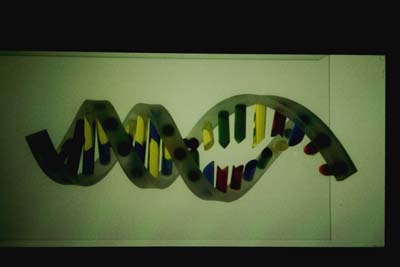

I’ve been driving due south, straight as an arrow for hours, through an endless, landscape of clear-cut rainforest, the sky the colour of lead, the highway slick with rain. Giant logging trucks send up huge rooster tails of slimy spray that settles on my windshield. The frenetic slapping of my hapless wiper blades can barely keep up. Most of the trucks carry loads of spindly second-growth fir, but I am shocked to be passed by one carrying logs from ancient, old-growth trees, probably over 300 years in age. Such loads are becoming rarer now that most of British Columbia’s ancient coastal forest has been liquidated, much of it in my own lifetime. It is hard to believe that the monotonous and ravaged landscape through which I have been driving was once completely covered with such giant trees, among the tallest on earth. Occasionally a ragged eagle flaps up from the broken-off snag of some ancient conifer, somehow left behind in the initial logging frenzy. It amazes me that eagles can still survive here. These enormous raptors seem like they are from another age. Maybe they’ve learned how to eat garbage. . . The highway is lined on both sides by a 3 metre tall fence, an impenetrable barrier to keep terrestrial wildlife off the road. It must be a powerful deterent. I’ve driven down this desolate highway dozens of times and have never seen a deer or one of Vancouver Island’s disappearing elk, anywhere near it. There is even a band of fine wire mesh at the fence’s base to keep out inquisitive rabbits. The old Subaru’s engine reeks of burning oil and carbon monoxide as it strains to maintain the 120 kph cruising speed.
Finally, pulling into Victoria, I slow down enough to see the snowdrops blooming, incongrously white in the dun metallic light of the late January afternoon. The pink flowers of Viburnum bodnantense, the colour of Barbie flesh and the spidery yellow little firework explosions of Chinese witchhazel glint out from behind the glossy green hedges of this surreal, faux England. I come to the end of the road, park the car and walk down to a limpid gray sea. In the distance, past the bobbing beds of kelp, past the invisible shipping lanes plied by endless convoys of container ships stuffing the maw of a million Wal Marts, looms the darkness of the Olympic peninsula. The sullen mass of America. Above it floats a faint, lens-shaped orange glow of what, were it not for the all-pervasive gloom, might pass for a sunset. The eye of Sauron?
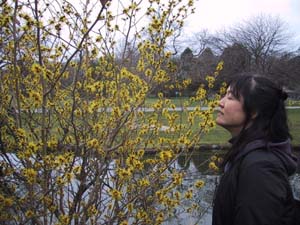
Chinese witch hazel
|
I’ve come to Victoria to attend Phillip Glass’s piano recital. Now, I’ve always thought that Mr. Glass was kind of a one trick pony. But what a magnificent trick! The mesmerizing tinkling, the mesmerizing tinkling, the mesmerising tinkling . . . . woven in and out by what can only be described as sonic musings. The notes develop the consistency of October rain falling on the Pacific. A scintillating pitter patter modulated by rolling, swell-like undulations. I am carried away by Witchita Vortex Sutra, written by Glass as an accompaniment to the words of Allan Ginsberg in 1973, during which Ginsberg declared the end of the Vietnam War while standing at the exact geographic centre of the United States of America. The war didn’t end with the utterance of this poem but maybe it helped spin the vortex of opposition a little faster. William Burroughs lived in Lawrence Kansas and died there in 1997. Glass talked about visiting him. I wonder if Burroughs clicked the heels of his ruby loafers when his number finally came up. There’s no place like home, even for Bill Burroughs. Somewhere in my boxes of junk, I think I have a silent super 8mm film of Burroughs giving a reading in Toronto, sometime in the early 1980’s. I’ll have to watch it again to see if it is *boring* or Fetish::Footage. Burroughs wasn’t exactly physically animated, even in life. I remember that he seemed to be in an oddly embalmed state, pickled perhaps by his own sardonicism. It was like he could live on its fuel forever.
Also in Glass’s program was an accompaniment he wrote for a performance of Jean Genet’s The Screens as well as a haunting piece Mad Rush, composed in honour of the Dalai Lama’s visit to the Cathedral of St. John the Divine in New York. The piece has no set ending and was written to be more or less played indefinitely because, as Glass recounted: it wasn’t clear as to when His Holiness was actually going to *show up.*
On January 21st, a couple of days after the concert, The New York Times reports in its ‘On this Day’ section, the 80th anniversary of the death of Lenin. His eternal question of “What is to be done?” still rings in my ears. Never before have the progressive aspects of socialism seemed so far from our grasp. Even liberalism has become a dirty word. Of course Lenin’s revolution failed in a multiplicity of ways. It more or less had to. But what talk is there now of a replacement for capitalism? We are left with neither baby nor bathwater. Perhaps we should replace our governments with the disembodied neurons of rats? Maybe that *is* what’s running the world. Only we don’t know it yet. . . Currently there is a robot located in Perth Australia, that is being controlled by a rat brain in a petri dish in Atlanta USA. The rat brain is telling the robot to make art. Check out slashdot’s lively discussion on this subject
An article in the always frighteningly interesting Defense Horizons, urges the Pentagon to continue the work of Cold War era Soviet scientists on protein-based electronics which use genetically engineered bacteriorhodopsin from an extremely old bacterium Halobacterium halobium to create *pattern recognition* devices. Bacteriorhodopsin has holographic properties which can be used to create biological, three-dimensional memory and *situation awareness* devices. Defense Horizons reports:
One such prototype device, using bacteriorhodopsin, can store 7 to10 gigabytes of digital data in a 1-centimeter (cm)-by-1-cm-by-3-cm polymer vial, capable of withstanding virtually any environmental abuse, including extended submersion in water. (By comparison, a typical personal computer comes with a storage capacity of 20 to 40 gigabytes.)
The article also describes hybrid biomolecular diodes that operate via photosynthesis, to make extremely efficient photo-voltaic converters. Such a protein-based photovoltaic coating on a soldier’s Kevlar helmet could produce enough power to run a laptop computer. It’s too bad that all of this amazing technology gets developed just to facilitate human slaughter. I’d love to be able to slap some of that protein-based photovoltaic coating on a bike helmet for example, and charge up my laptop as I rode down the street. (Of course that would be s-o-o geeky . . .)
And from the geek, (er) *meek* shall inherit the earth department: a microbe called Strain 121 has been identified which can survive exposure to 121 degrees Celsius, (250 Fahrenheit), well above the temperature used to sterilize hospital equipment, (or to boil water). These microbes belong in a family called archaea, single-celled microbes similar to, but not quite, bacteria. Archaea literally means “ancient,” and apparently these microbes can use iron in the same way that aerobic animals use oxygen, i.e. *they don’t need air to live* Given the horrific news that I reported on in my last posting, regarding the collapse of our planet’s biodiversity due to human-induced global warming, I somehow find the discovery of Strain 121 reassuring. Once we have left the scene, Strain 121 and its cohort of archaea will be waiting in the wings to re-start the process of evolution on the scorched earth we have left behind.

Mars: January 04 – “Shock and Awe”
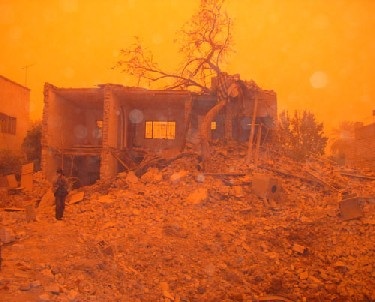
Iraq: March 03 – “Shock and Awe”
At this time of year, many people suffer from the blues. I seem to suffering from an annoying case of the ‘oranges’ (er, maybe the ‘reddish oranges’) Jim Bell of Cornell University and member of NASA’s Mars probe team told a press conference he was “in shock and awe” over the quality of the images delivered by Spirit’s panoramic camera. The orange tinted picture, shows a desolate plain full of small boulders and dust. It was eerily reminiscent of another kind of picture that we have been seeing a lot of lately. It seems sad, while humanity mounts its most determined effort ever to see if life once existed on the planet named for the god of war, that back here on earth life has never been cheaper. The picture on the right appeared on the ElectronicIraq.net site last March 27 and shows the aftermath of American cluster bombs dropped on a farm, just outside Baghdad. Four people were killed and many others gravely injured. The journalist recounted:
“Even the farm animals were killed. We were told that yellow cylinders landed in their yard, and when they and the animals crept closer to investigate, the bombs detonated.”
One eyewitness describes the aftermath:
“The sky took on colors I’ve never seen before in my 43 years. Every Iraqi I’ve talked to says they’ve never seen anything like it.”
Amidst all of the excitement about the search for life on the red planet, the journal Nature reports that our own earth is rapidly becoming a *dead* planet, with a staggering one million species of animals and plants predicted to go extinct within the next 50 years, due to habitat diminishment caused by global warming. Sadly, even species residing in protected areas will go extinct, as the climate changes around them. This happened recently to Costa Rica’s exquisite Golden Toad which vanished forever, after an unprecedented drought made its breeding impossible.

Golden toad: extinct 1991 |
Well at least we can look forward to Chinese New Year. January 22nd ushers in the Year of the Monkey. Orange trees are considered lucky by many Chinese, symbolizing good fortune and prosperity and hence are often displayed around the New Year. I snapped this pic of a beautiful pet orange tree in New York’s Chinatown.
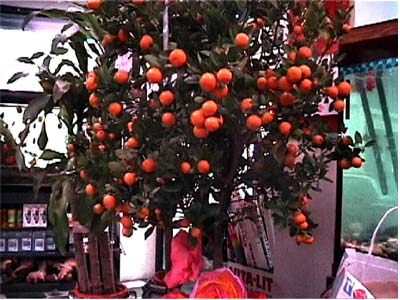
“Happy New Year to all my dear readers” |


suburban baroque
We’re driving around the confused fractal street scapes of a night-time suburbia when we came across an eerie aura glowing above a neighbouring cul-de-sac. We pull in and join a procession of cars solemnly crawling past split-level houses completely encrusted with seemingly trillions of multicoloured lights in a kind of Jack Smith meets Thomas Edison, American, kitsch rococco kind of landscape of the insane. Simulacrum snowmen flash-frozen while playing hockey. Did they look at the distant mall and get turned to pillars of plastic? An animatronic, bulb festooned, wire frame deer cocks its head at 30 second intervals, a thousand blinding and strobing incandescent bulbs exhort anonymous idling vehicles to have a *Merry Christmas* I become oddly nostalgic, as I remember my own father long ago, driving our family through similarly phantasmagoric displays of conspicuous uberwattage, on bleak pre-Christmas nights, deep within the vast street-maze of Toronto’s bedroom suburbs. As a child, I felt deeply comforted by the familiarity of schlock. I guess that is the allure of Disney. Like a motel toilet seat, reality has been ‘sanitized for your protection.’ And in suburban North America, the landscape itself has become a theme park. Micheal Sorkin edited an intriguing series of essays on this topic in his (1992) Variations on a Theme Park.
I guess we want to keep out the darkness at this time of year, which is always around the corner. But darkness can also be a great comfort, a kind of buffer against the shrillness of existence. Junichiro Tanizaki expounds on this in his exquisite extended (1933) essay, In Praise of Shadows Back in the 1930’s, Tanizaki was lamenting the aesthetic impact of the onslaught of an electrified modernity, but of course these days, Japan is anything but dark. Nuclear power took care of that.
Shohei Imamura is the filmmaker that for me best captures Japan’s uneasy post-war lurch into modernity, in particular the films Insect Woman, The Pornographers and especially his (1961) Pigs and Battleships otherwise known as The Flesh is Hot
And speaking of *flesh*, Mad Cow has finally been detected in the USA, despite having been there all along if, like me, you ascribe to the theory that John Stauber promulgates in his (1997) Mad Cow USA (now, incidentally available as a free download). Stauber has been keeping us well appraised of the developments. For example, he sent us a copy of an e-mail he received from organic dairy farmers Jim and Rebecca Goodman in Wisconsin, who were recently visited by a salesman selling blood-based cattle feed, which of course is a perfect vector for spreading more Mad Cow disease. Things in the American (and Canadian) food production systems have been systemically rotten for years and one can only hope that the shit will finally hit the fan over agribusiness-induced mad cow disease and its incurable human variant: Creutzfeld-Jacob. But hey, “the American system was never intended to keep sick animals from reaching the public’s refrigerators”, said Dr. Ron DeHaven, the Agriculture Department’s chief veterinarian in the New York Times. Stauber includes an image of the feed flyer which I am reproducing here. Note the plasma and serum ingredients. One way or another, a lot of beef-eating North Americans should be getting pretty *mad* this Christmas.

Once again I am technological meltdown mode. My I-book crashed and is off in the shop. . .
It turns out that some of Apple’s I-books have a design flaw, which causes the video chip to short out against the inside of the case, when the laptop gets *moved*.
Aren’t laptops supposed to get moved? Anyway, I’m reduced to blogging on the communal computer without (sigh) my bookmarks, or files.
So, I get to watch way more TV, and grow increasingly more apoplectic.
A case in point:
BBC World reported last week that gangsters in the Russian Far East are directing and producing big budget gangster movies starring- *themselves* AND, they use real bullets. I guess there is a lot of respect for the institution of authenticity in contemporary Russian film. Not even Godard could have come up with this interesting twist on Kino, but BBC World’s web site is so impenetrable and Byzantine, I couldn’t snag the link. .
PBS’s NOW reports that the National Rifle Association is mobilizing to buy up radio and television stations to get its “political message across” and to escape new rules, preventing groups that take corporate or union money from buying certain types of political ads on radio or TV 30 days before a primary or 60 days before a general election. It’s so much easier to buy a whole TV station than just some little old ad. Maybe those guys from the Russian Mafia could find a market for their films on “NRA TV.” Russia and America have so much more in common now that the Cold War is over. The NRA is even prepared to launch *pirate* radio stations from ships at sea to make Americans buy more guns. (I wonder if they’ll fly the skull and crossbones flag?)
Blogger has developed a weird new bug which *vaporizes postings* that I have been working on in draft mode. (Time to jump to Moveable Type !) I hope they get it fixed soon or I will really truly bail. I’m sure glad I’m composing in BBEdit . . .
I was pleasantly surprised to receive a few copies of the new Walrus magazine. I’m embarrassed to say that I stopped reading most Canadian magazines because they became so parochial and preachy, but Walrus is great ! The inaugural issue features a wonderful review by Lewis Lapham of the film McLuhan Reloaded, an homage to garbage by Douglas Coupland, an article on Tel Aviv becoming a Bauhaus World Heritage Site, and tons of other interesting stuff. I’m subscribing! So far, Walrus stacks up pretty nicely against the New Yorker and Harpers and it even has an easy to navigate website. And it’s *Canadian*
The folks over at travelersdiagram have been kind enough to link to my blog. Travelersdiagram links to a lot of amazing blogs. One of my favourites is geisha asobi who always has some very *whacked* links. This week she links (among many others) to J-Walk’s blog, who in turn links to the Connected Thesaurus which is extremely useful. Check out his links to an amazing image gallery called colofinder in which
aerial views of nuclear weapon storage areas caught my eye, as did the heavily visited messy cables.

Tent city in Vancouver 2003
It is of course abundantly obvious, that the much vaunted ‘market mechanism’ of late capitalism can’t or won’t provide even basic shelter for many living in our urban areas, regardless of the supposed employment rate or the “health of the economy.” I only need think back to 30 or so years ago, to when I was a kid growing up near Toronto. Visible homelessness then was more or less limited to a narrow demographic consisting of elderly substance-abusing men. Last time I visited Toronto, I saw entire families with children camped out over the hot air grates of the ultimate *cold city.* Vancouver is no better and tent cities have sprung up all over. The new economic brutalism is marginalizing an ever increasing portion of our population and there seems to be very little resolve by governments to do anything about it. In fact, visible homelessness has become a great tool for scaring the working poor into compliance with the Walmart economy. A case in point is British Columbia’s recent decision to cut 80,000 people off of the welfare roles by 2004, which the CBC predicts will result in 6,000 to 8,000 more people on the streets.
Let’s face it. It’s not impossible for most of us to imagine being homeless. What – with a bit of bad luck, and without a support network of family and friends, it might be closer than you think!
So, what to do? How can housing be constructed cheaply enough so that it can be *owned* by the rapidly increasing segment of our population that constitutes the *domestic third world*.
There has been some interesting thinking about this problem among architects lately, and a group working in Tokyo has come up with a very cool modular dwelling made completely out of polycarbonate plastic i.e, the cheap corrugated stuff that (ironically) real estate signs are often made of. While they quote a price of 350.000 yen (about $4300 CAN) to build one, I am sure it could be done much more cheaply in North America, as the Japanese prices for materials tend to be high. For less money than it costs for the government to subsidize slum landlords, the homeless could be given the materials and instructions on how to build these houses and be offered a safe place put them. What a radical idea! Home ownership for the homeless! These plastic houses can be built with just a box cutter, a saw and a screwdriver *and* they are completely portable.
Of course you need to be able to cook. Last summer, a student of mine, (A.K.A. Windy Day), showed me how to construct these lovely and highly efficient little rocket stoves out of discarded tin cans. The larger model burns sticks and pieces of paper extremely efficiently, and it is possible to boil water quickly with a minimum use of fuel. The smaller “pocket rocket” is made out of the bottom of a tomato paste can, jammed inside an aluminum beer can, which is crimped over and has tiny holes poked through it with a pin (see pictures). This little stove burns methyl hydrate (a common solvent) and can heat water in just a few minutes. The whole thing can fit in coat pocket:
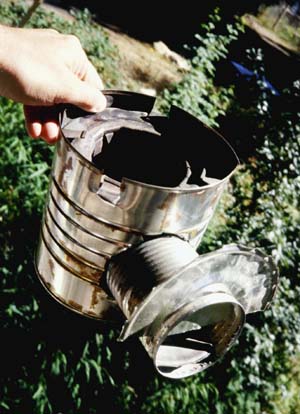
“rocket” stove (burns sticks and scrap paper)
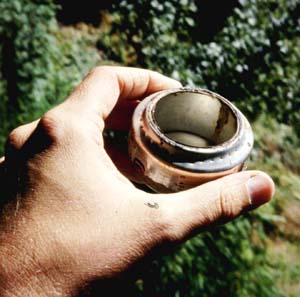
“pocket rocket” (burns methyl hydrate)
If your stuck in an economic refugee camp, why not start your own pirate FM radio station? Tetsuo Kogawa shows you how to build a neat little low power pirate transmitter for just a few dollars. I built one some years ago and it is so-o-o fun! The transmissions can be picked up on any conventional FM radio, (car, clock radio, whatever) and the range seems to be about 2 km. *Networks* of these little transmitters can be created, by connecting the earphone ‘out’ signal of a receiver (tuned to the pirate station), to the audio input of another pirate transmitter – thereby increasing the range indefinitely. This has classic bootstrapping potential !
“L’anarchie ! . . . .
|
|








